Apple Studio Display vs Samsung ViewFinity S9 5K -- compared
Apple Studio Display has a brand new competitor with the Samsung ViewFinity S9 5K. Here's how the two standalone monitors compare.
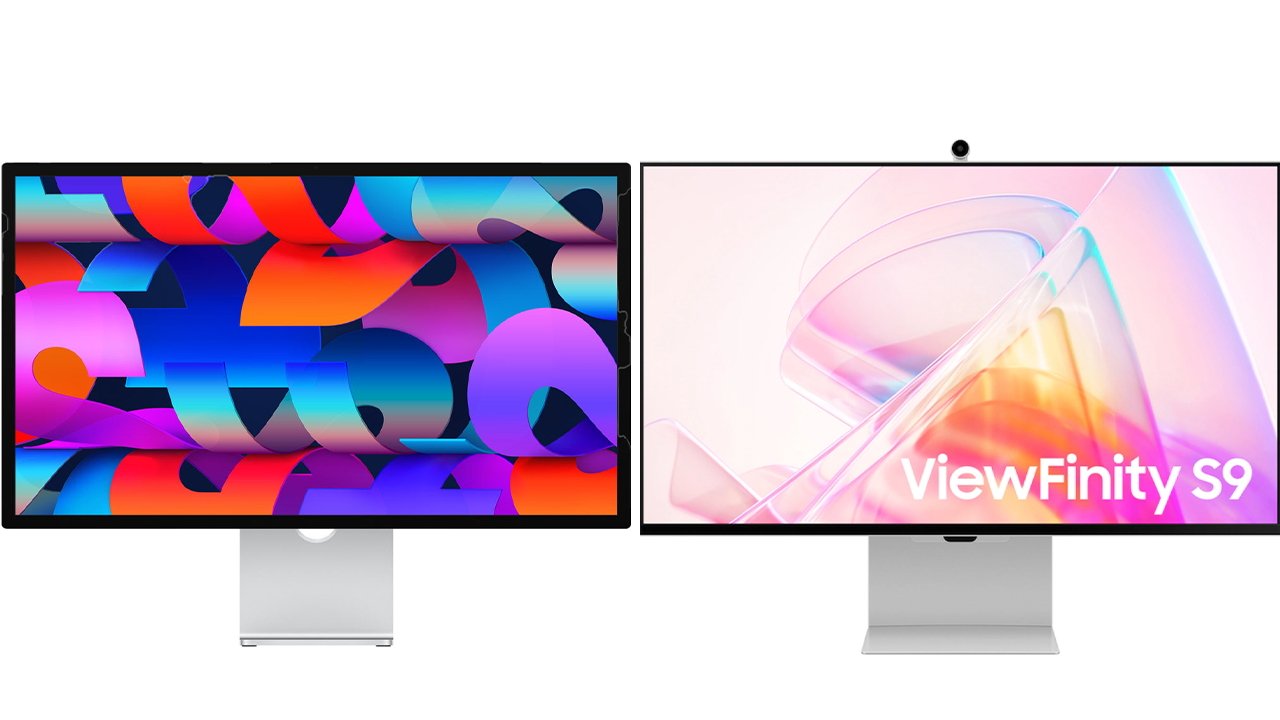
Apple Studio Display vs Samsung ViewFinity S9 5K
Apple discontinued the Thunderbolt Display in 2016 and waited five years before launching a similarly-priced replacement. The Studio Display launched in March 2022, with the LG UltraFine 5K positioned as its primary competitor at the time.
Samsung launched the ViewFinity S9 5K in South Korea in July. It finally became available in the United States in late August.
The two standalone monitors share similar feature sets, as far as the base Studio Display is concerned. However, Apple charges more for some of the features present on Samsung's option.
Here's how the two displays compare:
Apple Studio Display vs Samsung ViewFinity S9 5K: Specs
Considering price points and size, the two standalone monitors look similar on the specifications sheet. This might be enough to sway some potential customers looking to only spend around $1,599.
| Specifications | Apple Studio Display | Samsung ViewFinity S9 5K |
|---|---|---|
| Price | $1,599-$2,299 | $1,599 |
| Size | 27-inch | 27-inch |
| Resolution | 5120 x 2880 (5K) | 5120 x 2880 (5K) |
| Panel | LCD with IPS | LCD with IPS |
| Color range | P3 | P3 |
| Peak brightness | 600 nits | 600 nits |
| Aspect ratio | 16:9 | 16:9 |
| PPI | 218 | 218 |
| Refresh rate | 60Hz | 60Hz |
| Webcam | 12MP ultra-wide | 4K |
| Audio | 6-speaker system | 2-speaker system |
| Microphone | 3-mic array | Far-field mic |
| Display finish | Anti-reflective with optional nano-texture | Anti-glare with matte finish |
| Stand | Tilt, optional height+tilt stand +$400 | Tilt, height, and pivot |
| Weight | 13.9 pounds or 16.9 pounds with optional stand | 16.3 pounds |
They are nearly identical displays, when it comes to the specs sheet. However, the Studio Display does offer better microphones and speakers out of the box.
Meanwhile, Samsung offers some elements like the multi-point adjustable stand at no additional cost. Some buyers might also be enticed by the built-in 4K webcam as well.
Apple Studio Display vs Samsung ViewFinity S9 5K: Design and dimensions
The Apple Studio Display borders its 27-inch display with relatively thin bezels on every side. Samsung's ViewFinity S9 5K follows along with the same design language, keeping the monitor's overall sleek design.
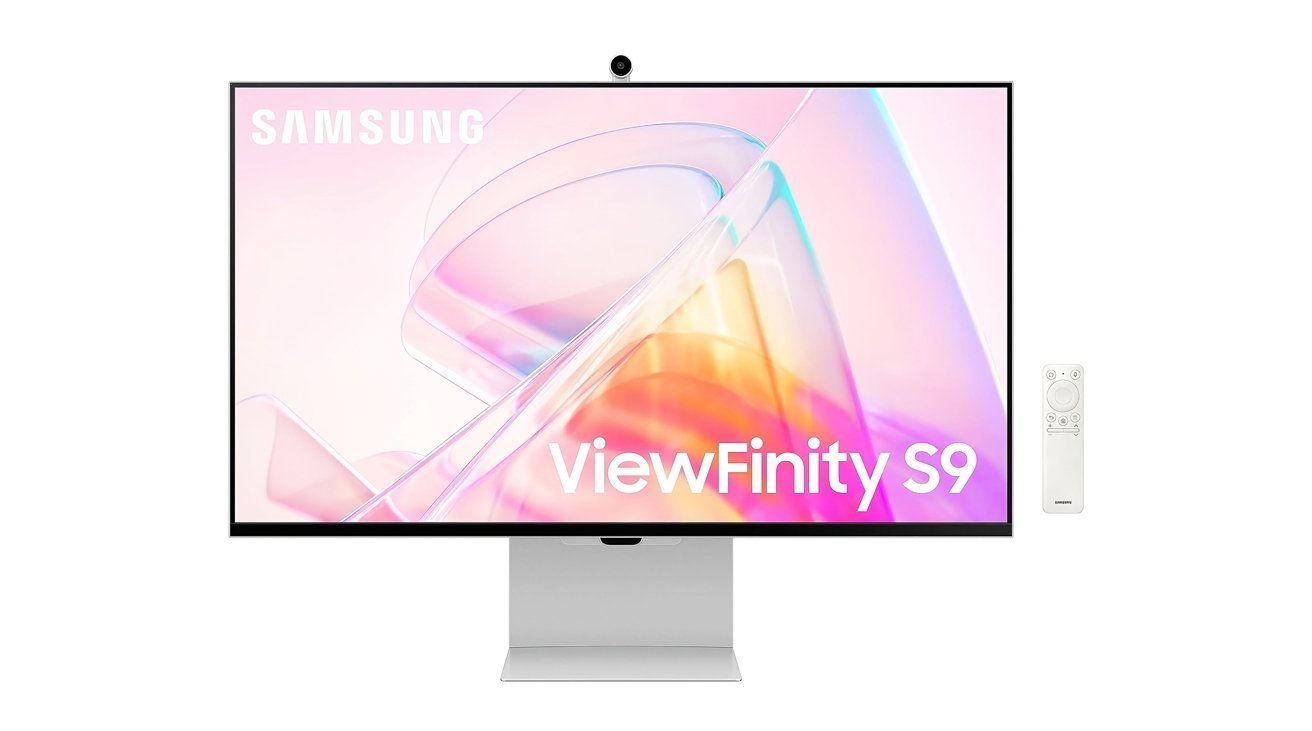
Samsung ViewFinity S9 5K
The ViewFinity S9 5K comes standard with a stand that offers height, tilt, and pivot adjustment options. To get the Apple Studio Display with a similar stand, customers will need to pay $400 more.
The Studio Display relies on an aluminum build throughout, including the stand itself and the back panel. Samsung's ViewFinity S9 5K has an aluminum stand, but the back panel is plastic.
The Samsung ViewFinity S9 5K weighs 16.3 pounds, while the standard version of the Studio Display weighs 13.9 pounds. Adding the optional stand with tilt and height adjustments adds three pounds to the Studio Display.
Apple Studio Display vs Samsung ViewFinity S9 5K: Display
The displays in the two standalone monitors are roughly the same, as far as specs and features are concerned. They are both 27-inch LCD panels that support sRGB and DCI-P3 for color accuracy, depending on each user's needs.
They both feature 60Hz refresh rates and can reach 600 nits of peak brightness. Apple offers True Tone technology with the Studio Display, while Samsung's monitor features Intelligent Eye Care to reduce blue light, optimize brightness, and more.
The Apple Studio Display has a contrast ratio of 1,000:1, with none of the local dimming that the Pro Display XDR offers. The Samsung ViewFinity S9 5K features a contrast ratio of 1,000:1 and no local dimming.
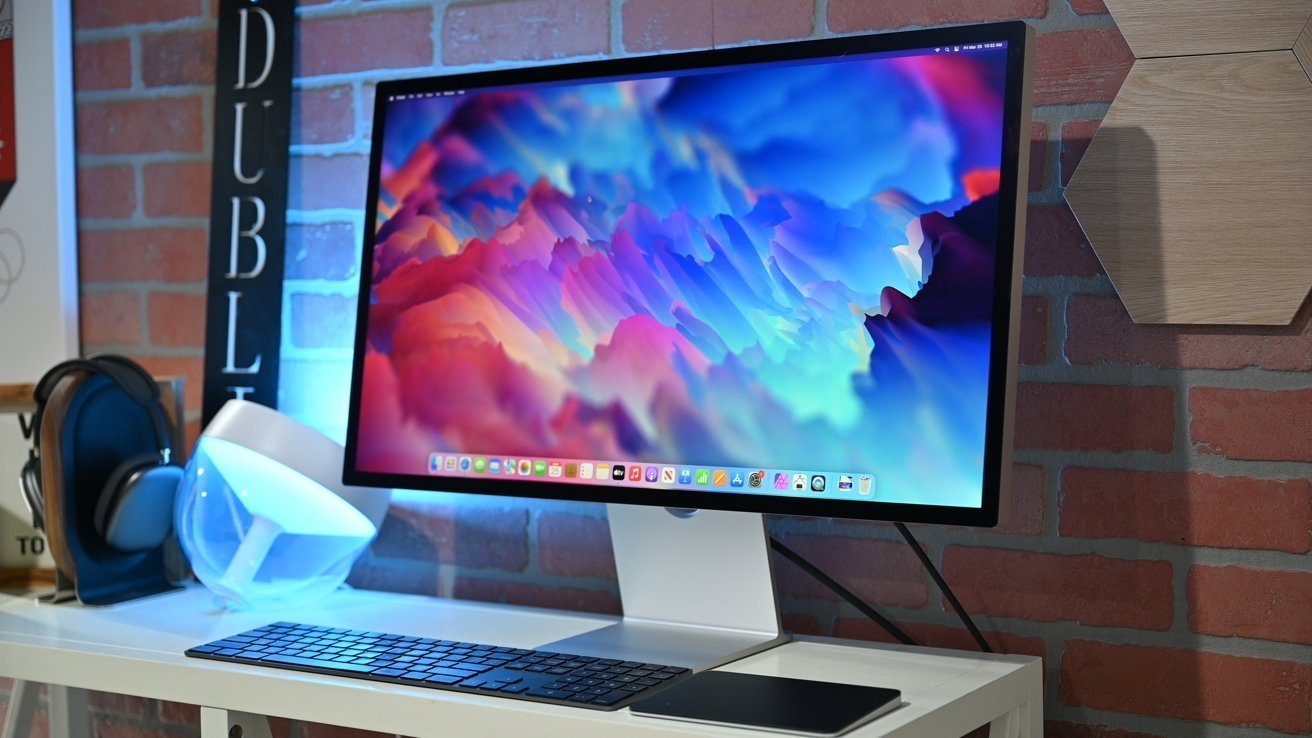
Apple Studio Display
The standard version of the Studio Display has an anti-reflective screen, which will reduce overall glare. The optional nano-texture glass is optimal for reducing glare in rooms with bright light sources, including sunlight.
Samsung's ViewFinity S9 5K features a Matte Display, which will reduce light reflections without obscuring the user's view.
The Samsung monitor also features a dedicated companion smartphone app. With the app, users can quickly calibrate their display based on their needs, including switching to modes like DCI-P3 and sRGB.
Apple Studio Display vs Samsung ViewFinity S9 5K: Connectivity
The Apple Studio Display and Samsung ViewFinity S9 5K feature three USB-C ports, while the Studio Display has a single Thunderbolt 3 port and Samsung's has a single Thunderbolt 4 port.
The Studio Display has three USB-C 3.1 Gen 2 ports, with up to 10Gbps speeds. Samsung does not specifically mention the type of USB-C ports on the back of the ViewFinity S9 5K, so it may be USB-C 3.0. If that is the case, it will top out at 5Gbps.
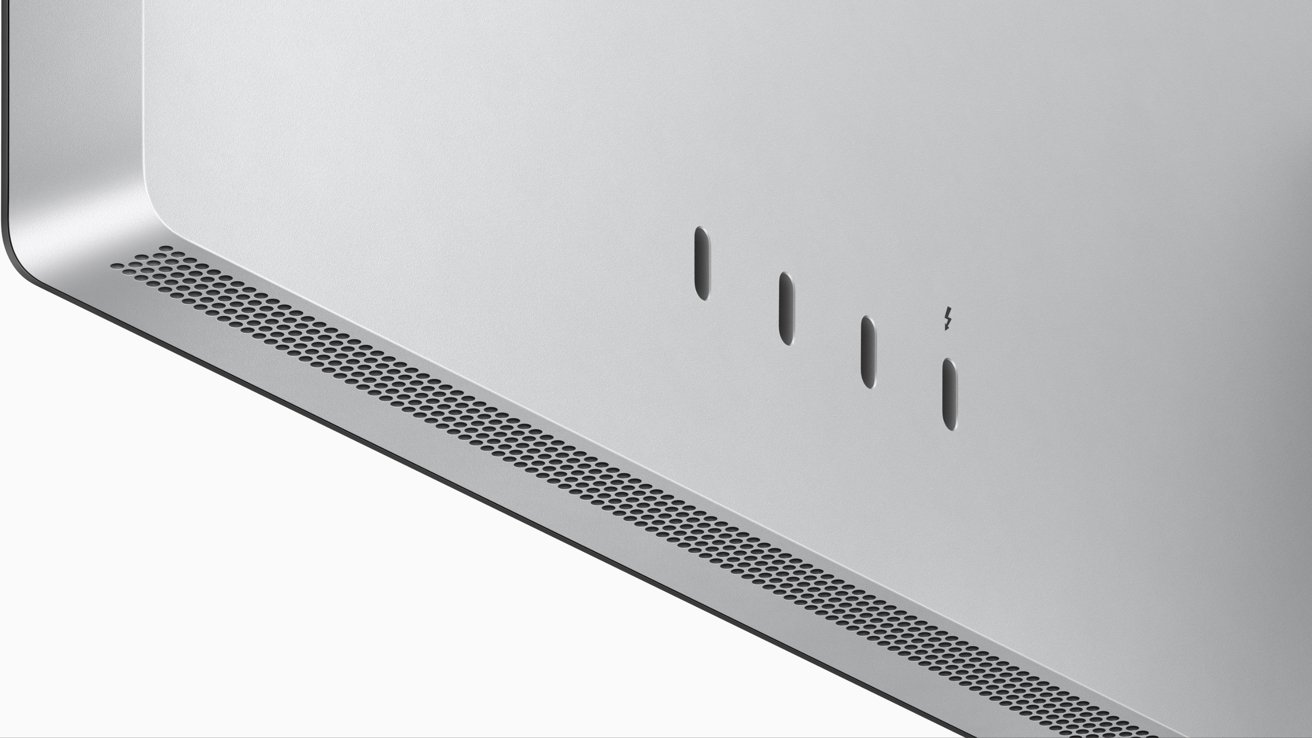
Apple Studio Display ports
Studio Display owners will get 96W of power delivery, while the ViewFinity S9 5K will output 90W. In both cases, the standalone monitors can charge a notebook like a 16-inch MacBook Pro easily enough.
The Samsung ViewFinity S9 5K does offer some key elements the Studio Display does not, including AirPlay support and Smart Hub TV features. The ViewFinity S9 5K also has a single mini DisplayPort.
While the Studio Display does not support AirPlay directly, users could use a connected Mac or MacBook to use the feature if they need to.
Samsung also notes that only Apple Silicon-based "Mac computers" released since 2020 are supported by the ViewFinity S9 5K.
Apple Studio Display vs Samsung ViewFinity S9 5K: Camera and audio
The Apple Studio Display's webcam is built in, while Samsung's SlimFit camera is detachable. Apple's option is the same 12-megapixel ultra-wide camera that is present in the latest iPad Pro.
Apple's camera also supports a 122-degree field of view and Center Stage, with an f/2.4 aperture. Samsung does not go into great detail about the 4K SlimFit camera that ships with the ViewFinity S9 5K.
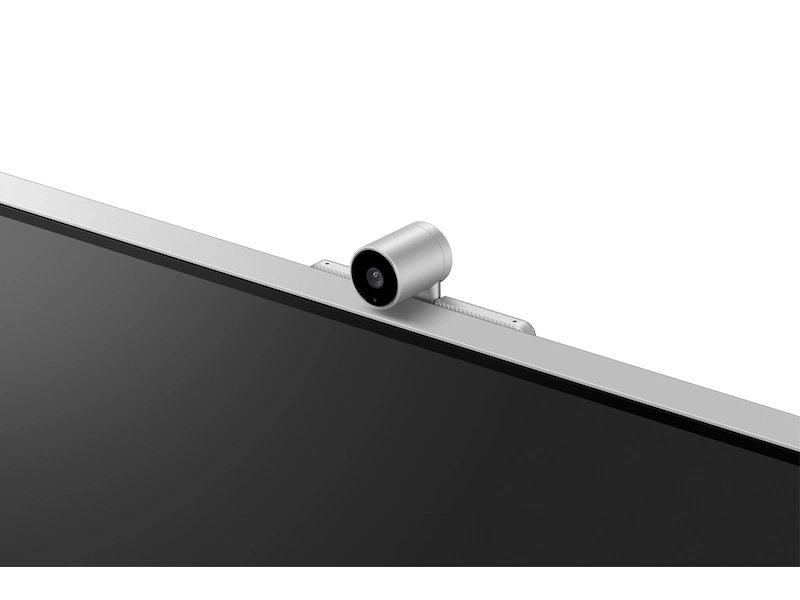
Samsung ViewFinity S9 5K SlimFit 4K camera
Apple's Studio Display is equipped with a six-speaker array, consisting of four force-canceling woofers and two tweeters, complete with Spatial Audio support. Apple's monitor also boasts a studio-quality three-mic array.
The Samsung ViewFinity S9 5K is equipped with a pair of speakers that can output 5W and a far-field microphone.
Apple Studio Display vs Samsung ViewFinity S9 5K: macOS
The Samsung ViewFinity S9 5K will work like any standard standalone display when connected to a Mac. While the display does technically have AirPlay 2, while the Studio Display does not, Samsung's monitor does not offer any specific macOS- or Apple-specific features.
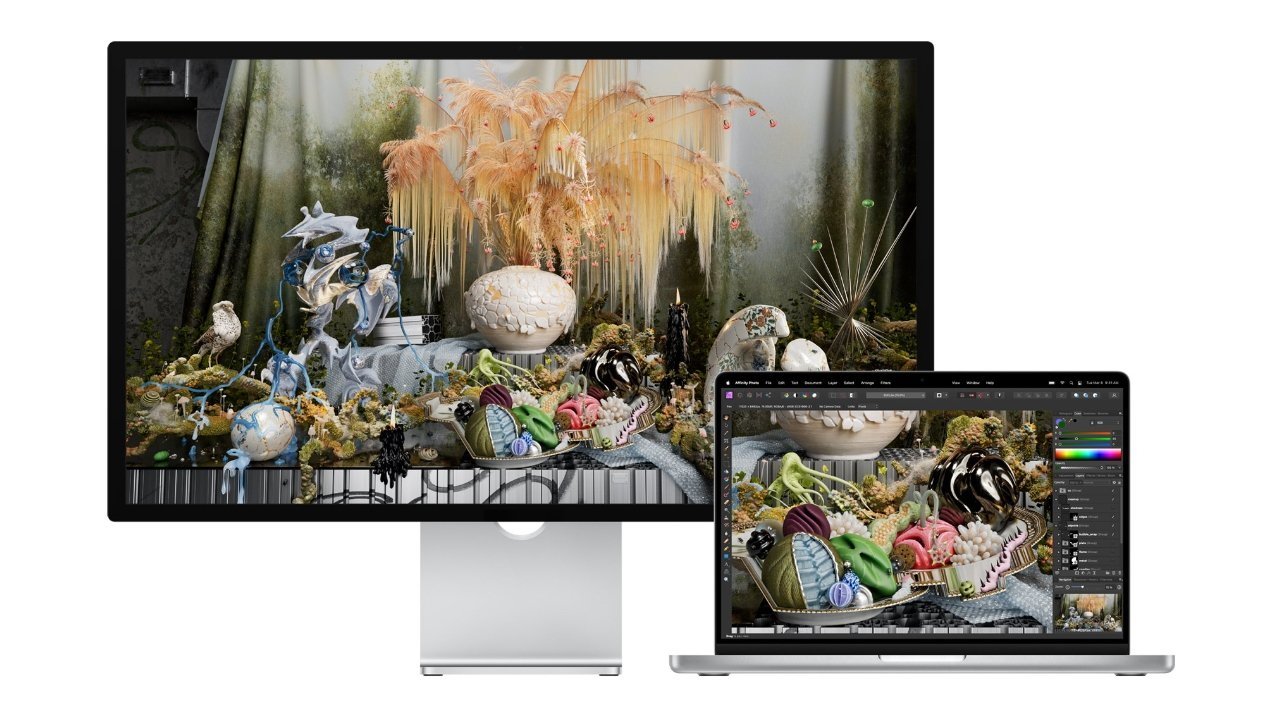
Apple Studio Display and macOS integration
The Apple Studio Display is equipped with an A13 processor inside, meaning it is capable of utilizing Apple-specific features. Those include Spatial Audio, a range of different reference modes built into macOS, "Hey Siri," and Center Stage.
Apple Studio Display vs Samsung ViewFinity S9 5K: Price and where to buy
Apple launched the Studio Display in March 2022, with a starting price of $1,599 with standard glass. Adding nano-texture glass bumps the starting price to $1,899.
The tilt-only adjustable stand does not add anything to the price. However, adding the tilt- and height-adjustable stand will increase the price to at least $1,999. The VESA mount adapter bumps the price to at least $1,599.
Samsung's ViewFinity S9 5K retails for $1,599.99 and ships with the tilt- and height-adjustable stand, a physical remote to control Smart Hub TV features, and a matte finish display.
Apple Studio Display vs Samsung ViewFinity S9 5K: What to buy
The Apple Studio Display and Samsung ViewFinity S9 5K share many of the same specifications right out of the box. This makes either option a worthwhile choice as far as a standalone monitor itself is concerned.
For users already in the Apple ecosystem, and for anyone who is using an Apple computer that's not equipped with Apple Silicon, the Studio Display is likely the option to consider. With the A13 processor inside unlocking features like Center Stage, Spatial Audio, reference modes, and more, it has a leg up within the Apple ecosystem.
The Samsung ViewFinity S9 5K does come standard with a stand that can tweak tilt, height, and pivot settings, while the Apple Studio Display does not. If the potential buyer's workstation requires more subtle positioning and they don't want to spend more money on Apple's display system, Samsung's monitor is worth considering.
Apple Studio Display vs Samsung ViewFinity S9 5K: Where to buy
The Apple-branded monitor is available at a discount at Apple Authorized Reseller Adorama when you apply coupon code APINSIDER during Step 3 of checkout. Amazon, Best Buy, and other major retailers also carry the display.
The ViewFinity S9 5K is available from Samsung's website, Amazon, Best Buy, and other third-party retailers.
Read on AppleInsider

Comments
This implies the 4k (~8.3MP) is better than the 12MP camera. Just saying...
First of all, note that the MP doesn't account for the aspect ratio. I think 4K @16:9 is around 8.3 MP. What does FaceTime use?
Additionally, this camera has been plagued with issues and I'm not sure it's been resolved. To me, this issue is particularly odd because it seems like something you'd expect Apple to not only want to get right before shipping, but have no issue getting right seeing as how it's using technology you'd think they mastered years ago with the known camera component and A13 Bionic chip.
Quotes from John Carpenter’s The Thing
BLAIR: You see, what we’re talking about here is a Samsung display that imitates an Apple Studio Display, and does it badly. When this Thing attacked Apple it tried to digest a Studio Display… absorb it, and in the process shape its own structure to imitate a Studio Display. This for instance. That’s not an Apple Studio Display, it’s an imitation. We got to it before Samsung had time to finish.
NORRIS: Finish what?
BLAIR: Finish imitating the Apple Studio Display.
I love my Studio Display by and large, but the FaceTime camera is indeed atrociously bad. I mean, I say that as an avid 20+ year Apple Kool-aid drinker lol, it's pathetic in a $1600 product that they couldn't do any better than that and seems like a massive oversight for a company so focused on the user experience. At least it is convenient to have it built-in instead of the old $40 Logitech webcam I had duct taped on top of my old monitor... Although that thing too had better image quality haha. Overall still please with my new display, just wish they could have done better there. And for the same price as the Samsung "knockoff" I'd rather have the real deal on my desk!
https://sixcolors.com/post/2023/09/review-27-inch-samsung-viewfinity-s9-display/
Good review. You should read it.
Teaser: Classic story of the specs not telling the whole story.
AppleInsider always gets the rejoinders regarding the ViewFinity S9 camera because this is about the 2nd or 3rd time that they have claimed that the ViewFinity S9 4K camera is better than the ASD 12MP camera, without stating why. There is probably a good reason, they just need to state it, and even then it will have to come with a caveat since they don't know how this 4K camera in the S9 will perform. So, definitely deserved pokes in the eye imo.
The simple explanation is that the ASD 12MP camera, assuming a 16:9 sensor, has 4620 pixels spread across a 122° field of view, making for 38 pixels per degree. The ViewFinity S9 camera, which also offers a Center Stage type feature, has 3840 pixels spread across a 60° to 100° field of view. Nobody knows what the FOV is. If it is 60°, 64 ppd. If it is 90°, it is 43°. Obviously it will be worse than the ASD cam if it is ultra wide over 100° FOV.
These large displays present difficult design and feature issues from cameras. The bigger they are, the worse getting a face centered in the FOV becomes. Probably one of the reasons the Apple Pro Display XDR doesn't have one built in. Eventually, I think OEMs will have to put multiple cameras on a display and fuse the videos into 1 view where it shows the users look straight at whatever they are looking at. Something like this will probably go into the iPhone first though. Maybe iPad?
samsung is either just milking US Mac customers, or it intends to regularly offer sweet discounts. I would not pay the same price as a studio display for the viewfinity, and I reckon Samsung plans to sell at a discount, so wait for those.
OK so it's missing Center Stage, Spatial Audio and six speakers. Are these important on a desktop or bedroom screen?
A big-ass, 27'' 5K screen priced as an iPhone should, at the very least, have an iPhone-level webcam… Heck, considering how Logitech sells mounts for iPhones (and anyone minimally resourceful can produce their own, like the one I made out of LEGO Technic parts) and how Apple Sherlocked Camo Studio – or at least tried to, because their implementation is still buggy –, it's downright idiotic to put such a crappy camera on their “mainstream” display (it's still too expensive, if you ask me).
If you want USBC ports in the display, 6K 60 Hz is basically the limit for Thunderbolt 3/4 unless you resort to display stream compression, which I have not seen anyone do. It can actually support 8K 30/60 Hz if an OEM is willing to basically turn it into an HDMI 2.1 port, by making it unidirectional at 80 Gbit/s. You lose the single cable lifestyle. Apple has to wait for Thunderbolt 5 which is 80 Gbit/s bidirectional. That should be enough for 6K 120 Hz or 8K 60 Hz.
Jason Snell said the ViewFinity S9's USBC ports are 480 Mbit/s (USB2), so, not sure what Samsung is doing with that.
You can use the ASD with a Windows PC. You likely need an actual TB cable, an actual TB port (not just USBC), and the display, speakers, microphone and camera will work. You won't get Center Stage (not sure if the monitor will de-distort the wide angle into normal angle), Spatial Audio, Hey Siri functionality, or other macOS specific stuff.
That's downright annoying if you are plugging things into those USBC ports.